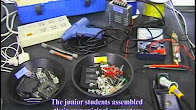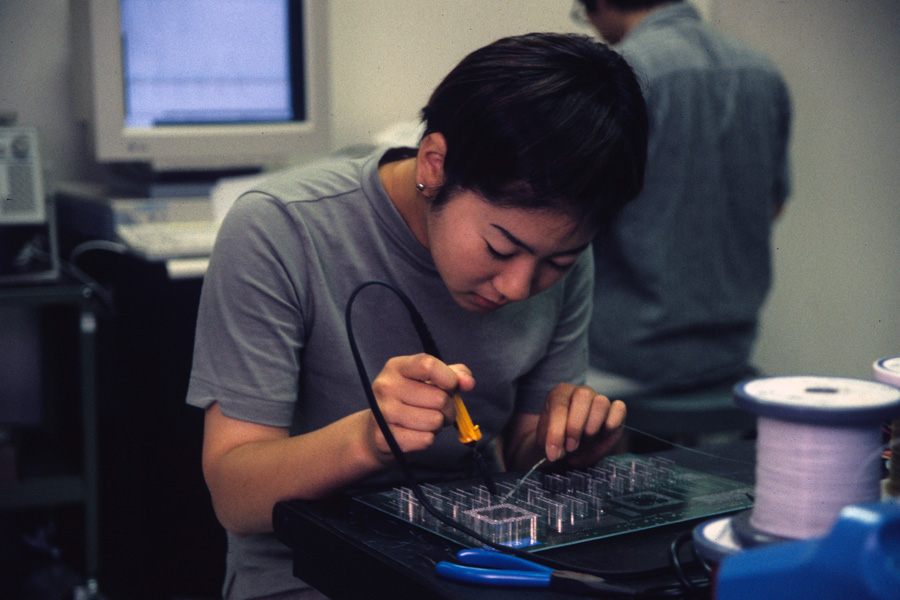Microcomputer Design Educational Environment City-1 on Verilog HDL and FPGA in 1999
for the junior students of the Department of Computer Engineering,
Faculty of Information Sciences, Hiroshima City University

|
A video City-1 goes on is introducing the next 2 years (1999-2000) of City-1, which is an educational course held successfully by Ryuichi TAKAHASHI in microcomputer design using field programmable gate arrays (FPGAs) for the junior students of the Department of Computer Engineering, Faculty of Information Sciences, Hiroshima City University until 2008.
|
In the summer of this year, on an internet forum, Japanese
engineers were talking about a seminar, where a U.S. semiconductor vendor
asked them "have you ever built a model plane." Typical
Japanese engineers are too shy to answer "yes", even if they had many
experiences. But, in anyway, "One who can not
understand the pleasure to build something can not be a good
designer."
It is true that even ready-made board can be used for some design
education if the board contains FPGAs. But, the students can not
enjoy this pleasure to build. This is the very reason why this
educational environment provides the entire design and manufacturing
experience to the students; from concept to implementation. And, until
the last year, we had made grate efforts to increase the number of
successful completion by
- " Short-step education": The entire course had been divided into short
steps to make it easy to follow for all of the students.
- "A supplementary lesson in the summer vacation": The students who can not
keep up with the others had been given extra classes.
We did not know if this was too much or not. But, in anyway, these resulted in a delay; about two weeks. This
course had been met with severe criticism for this delay by a few
professors. There was also a power failure by a thunder shower, which
made this delay worse in 1998.
We wish we could allow all of the students to spend enough time to
complete the entire phases. But,"A professional carry out heavily technical works as easy
as pie always, even in the cases where these are not at all." "A professional regards his competence is still green, if
he could not carry out his work as he should do, even under severe
conditions." In anyway, this course is far easy in comparison
with the real engineering in the market. We also think about the
importance to teach completing something within a limited period. So
we have changed the educational policy in 1999:
- All teaching materials should be given to the students as early as possible.
- From the beginning, the students should be announced that there
will be no supplementary lesson in the summer vacation.
All debugging effort was terminated by the last day; Friday July 16th.
(In Japan, the school year begins on the April and ends on the March
of the following year.) Until this last day of the first term of this
year, 41 students, out of 47 students, succeeded to
complete. Euclidean algorithm to calculate both the greatest common
measure(GCM) and the least common multiple(LCM) was given as the
specification that should run on their machines. This high completion
rate; 87% is the same as the rate in 1987 and, this time, there was no delay.
Next week, from July 19th, an international conference was held in Washington,D.C., which was the first opportunity for me to introduce City-1 to the world. Although the subject should be about pipelining, I still tried to spread the "horizontal microcode like state assignment for the control unit," which enables us to have hardwired sophisticated control mechanism.
Ryuichi TAKAHASHI and Noriyoshi YOSHIDA:
"Diagonal Examples for Design Space Exploration
in an Educational Environment CITY-1"...ACM,
IEEE
IEEE Proc. MSE 1999: International Conference on
Microelectronic Systems Education, pp.71-73 (1999)
Ryuichi TAKAHASHI
|
The best design awarded machines:
 |
 |
 |
 |
 |
 |
Mayumi
ARATA(F) |
Takashi
KISHIDA |
Tsuyoshi
SHIMADA |
Megumi
HISAYUKI(F) |
Kohei
FUKEDA |
Takuya
MATSUMOTO |
This year, many students tended to seek the minimum effort
saying "Simple is the Best." The pioneers are included in the above
list. The other students are awarded by the spirit to ignore this
tendency by increasing the number of registers, introducing 2's
complement additions and stack pointers. The prudence, which is
necessary to became professional, are found in all these students
commonly.
Some promising youths were also found in the following list. The
important thing is to learn something through this course and to
become a good engineer for the human life.
|
Sound CISC machines:
 |
 |
 |
 |
 |
 |
Takeshi
UCHIONBO |
Seiji
Ouwa |
Shinya
OKAMOTO |
Hideki
OKINO |
Masayoshi
OZAKI |
Chie
KURAMOTO(F) |
 |
 |
 |
 |
 |
 |
Naotoshi
KUREMACHI |
Chikako
SHIMOMURA(F) |
Kazushi
SHINTANI |
Kanako
SUEZAWA(F) |
Masanobu
TAKEGAWA |
Kouhei
TAKEGUCHI |
 |
 |
 |
 |
 |
 |
Kazuhide
TAKESHITA |
Yasuhiro
NAGATA |
Takayuki
NOGAMI |
Takeshi
HIRAMATSU |
Takahiro
FUKAMI |
Chie
FUJIWARA(F) |
 |
 |
 |
 |
 |
 |
Hisanori
HONDA |
Sayaka
MATSUNAGA(F) |
Atsushi
MIYAKE |
Akane
MIYOSHI(F) |
Aya
MURAKAMI(F) |
Jun
YAMAKAWA |
 |
 |
Takuya
YAMAMOTO |
Masaki
YOSHIMURA |
Sound RISC machines:
 |
 |
 |
 |
 |
 |
Keisuke
SATOH |
Yukiyoshi
JUTORI |
Kazuhiro
SERA |
Hiromi
TANIGUCHI |
Tadahiro
NAKAMURA |
Yousuke
NAKAMURA |
 |
 |
 |
Nozomi
NAKAWAKI |
Takuya
MINAMI |
Tomonari
YAMAUCHI |
|














































